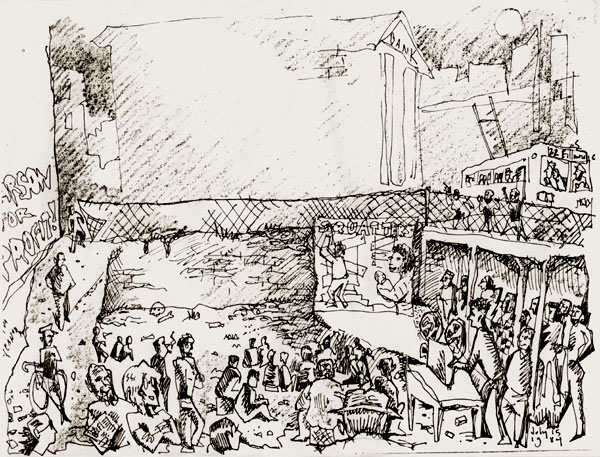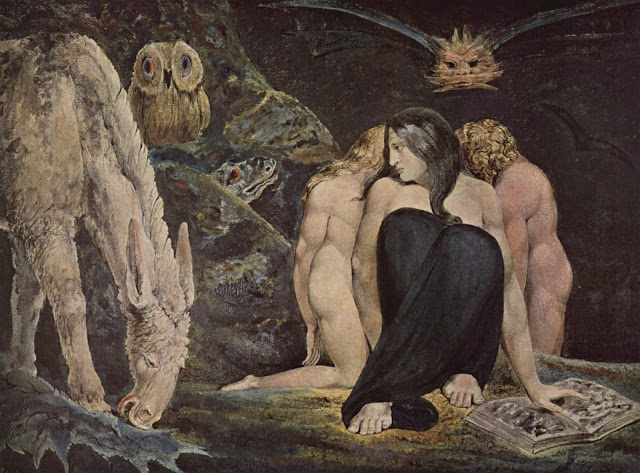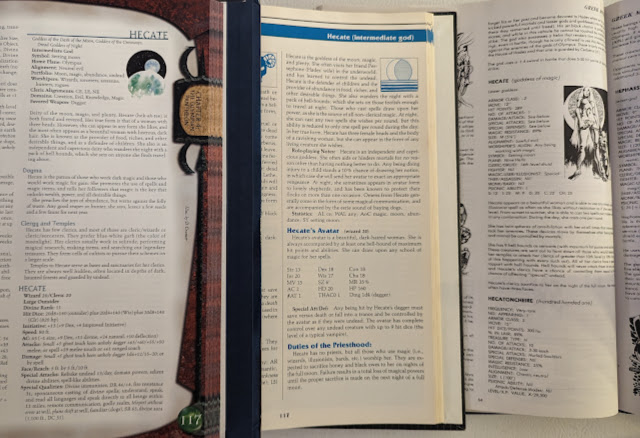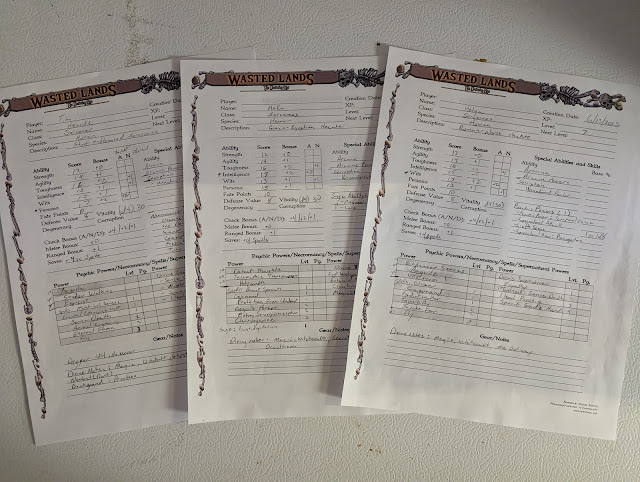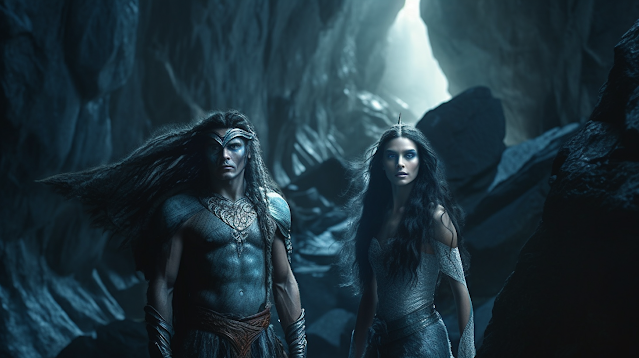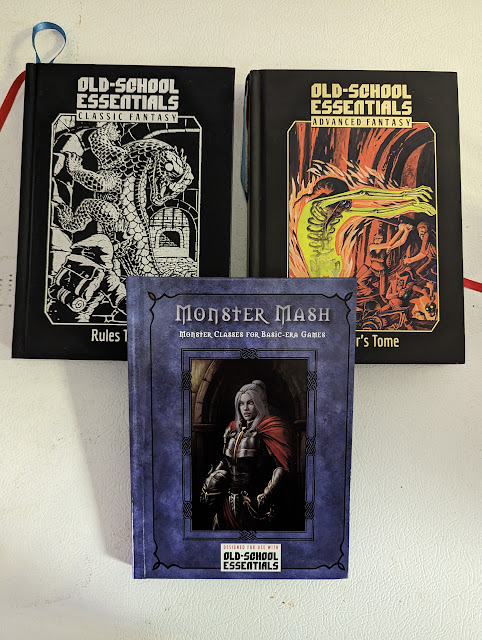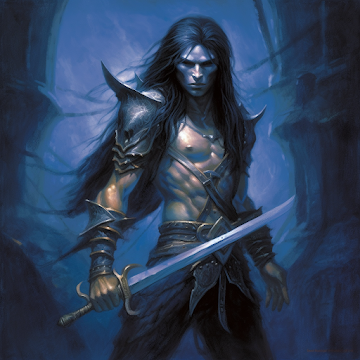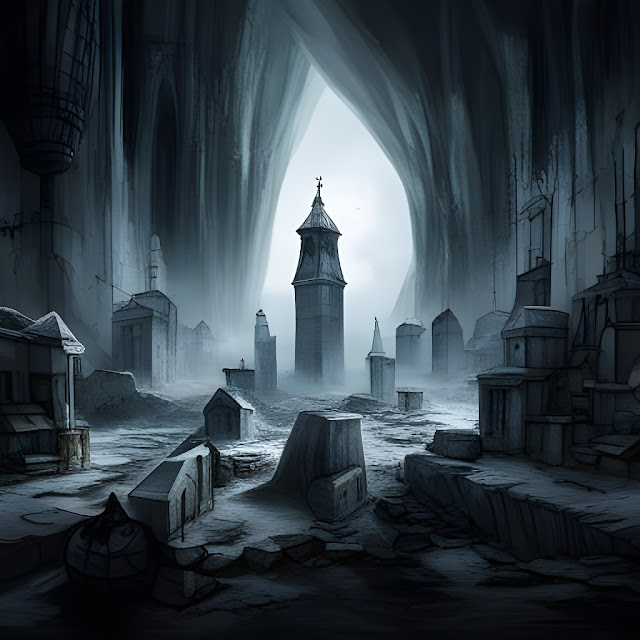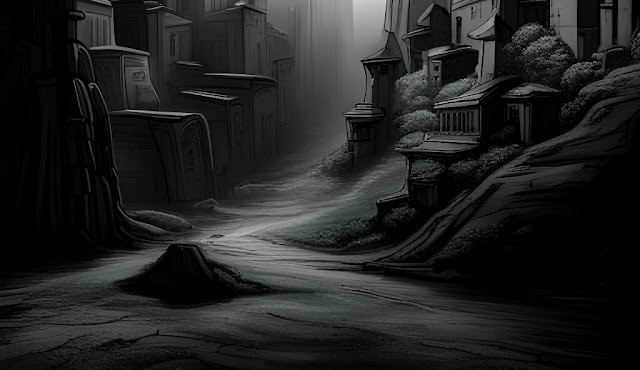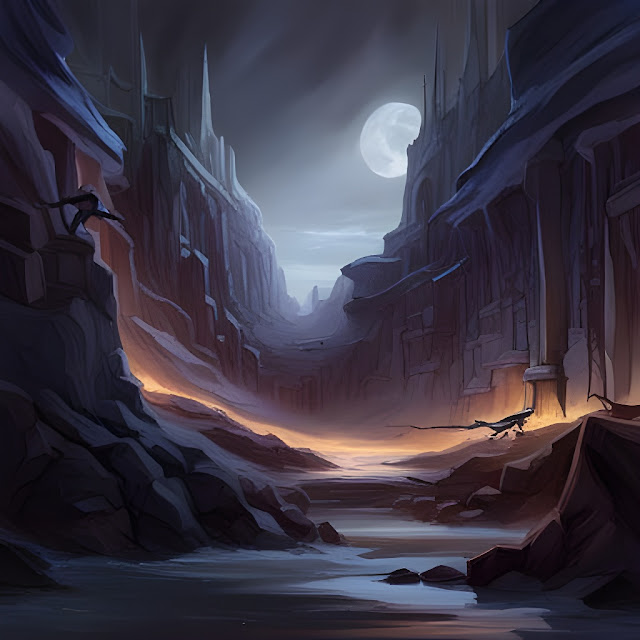
First seen in
Numenera, a Science-Fantasy RPG set a billion years into the future published a decade ago and then in the multi-realm hopping
The Strange, the mechanics of what would become the
Cypher System have since been seen in multiple settings and genres and roleplaying games and gained a generic rulebook of their own so that the Game Master can use them to create and run settings of her with dynamic Player Characters. They are designed to be flexible and adaptable and enable players to create characters that do things. The rules enable the use of various powers and abilities by focusing on their effects and how they are perceived in a setting or genre. For example, a fire bolt in a fantasy campaign could only be cast by a wizard, but in Science Fiction setting, it can only be pyrokinesis! Published by
Monte Cook Games, The
Cypher System Rulebook includes not just a full explanation of the rules and the means to create a wide range of characters and archetypes, plus a bestiary and extensive equipment lists—including the all-important near magical cyphers and artefacts, but also an overview of nine different genres and advice on how to do them using the
Cypher System.
The
Cypher System Rulebook begins with a quick explanation of the system’s mechanics before focusing upon the Player Character. A Player Character in the
Cypher System has three stats or Pools. These are Might, Speed, and Intellect, and represent a combination of effort and health for a character. Typically, they range between eight and twenty in value. Might covers physical activity, strength, and melee combat; Speed, any activity involving agility, movement, stealth, or ranged combat; and Intellect, intelligence, charisma, and magical capacity. In game, points from these pools will be spent to lower the difficulty of a task, but they can also be lost through damage, whether physical or mental. A Player Character has an Edge score, tied to one of the three pools. This reduces the cost of points spent from the associated pool to lower the difficulty of a task, possibly even to zero depending upon the Edge rating. A Player Character will also have a Type, which can either be an Adept, which uses powers akin to magic or psionics or superpowers—depending on the genre; Warrior, a soldier or a police officer or warrior; Speaker, conman, diplomat, or gambler; or an Explorer, an archaeologist, investigative journalist, or treasure hunter. Essentially, these are archetypes which a player can modify as a game progresses over the course of several sessions.
However, what defines a Player Character is a simple statement—“I am an adjective noun who verbs.” The noun is the Player Character’s Type, whereas the adjective is a Descriptor which describes the character and verb is the Focus, or what the character does. For example, “I am a Cruel Adept who Was Foretold”, “I am Brash Warrior who Brandishes an Exotic Shield”, “I am a Charming Speaker who Entertains”, and “I am a Rugged Explorer who Explores Dark Spaces”. This encapsulates the Player Character in the case of the Descriptor, Type, and Focus, provides points to assign to his three Pools, special abilities, skills, and a point in an Edge. To this is added a connection to world and through this to the other Player Characters, plus a Character Arc, which provides a story that the character and player can invest themselves in as well as providing a means of earning Experience Points. Although there are only four character Types, there are some fifty Descriptors and over ninety Foci for a player to choose from, providing for a wide range of Player Characters in a simple, familiar format. To create a character, a player selects a Descriptor, Type, and Focus ,and chooses from the options given under each.
The two sample Player Characters include a standard scholar type character who has seen military service and who would rather spend time with his books and a darker character more suitable for an arcane style of game. Not only does the
Cypher System Rulebook include a wide array of options in terms of its characters, it includes guidelines to help the Game Master create further Descriptors and Foci for her own setting, plus adding ‘Flavour’ to colour a character that a player wants.
Henry Brinded
“I am an Intelligent Explorer who Would Rather Be Reading.”
Tier 1 Explorer
Might 10 [Edge 1] Speed 11 Intellect 15
Effort 1
Abilities: Light and medium weapons, Danger Sense, Decipher, Knowledge Skills, Practiced with all weapons, Knowledge is Power
Skills: Archaeology, History, Occult, Memorisation, Persuasion, Sailing
Arc: Enterprise
Kossos
“I am a Cruel Adept who Was Foretold.”
Tier 1 Adept
Might 7 Speed 12 Intellect 17 [Edge 1]
Effort 1
Abilities: Expert Cypher Use, Light Weapons, Far Step, Magic Training, Scan, Ward, Cruel attacks
Skills: Deception, Intimidation, Persuasion (All related to pain), See through deception, public speaking
Inability: Hindered with motives or emotions
Arc: Mysterious Background
Mechanically, the
Cypher System is player facing—and arguably was one of the first systems to be player facing. Thus, in combat, a player not only rolls for his character to make an attack, but also rolls to avoid any attacks made against his character. Essentially this shifts the game’s mechanical elements from the Game Master to the player, leaving the Game Master to focus on the story, on roleplaying NPCs, and so on. When it comes to tasks, the character is attempting to overcome a Task Difficulty, ranging from one and Simple to ten and Impossible. The target number is actually three times the Task Difficulty. So, a Task Difficulty of four or Difficult, means that the target number is twelve, whilst a Task Difficulty of seven or Formidable, means that the target number is twenty-one. The aim of the player is lower this Task Difficulty. This can be done in a number of ways.
Modifiers, whether from favourable circumstances, skills, or good equipment, can decrease the Difficulty, whilst skills give bonuses to the roll. Trained skills—skills can either be Practised or Trained—can reduce the Difficulty, but the primary method is for a player to spend points from his relevant Stat pools. This is called applying Effort. Applying the first level of Effort, which will reduce the target number by one, is three points from the relevant Stat pool. Additional applications of Effort beyond this cost two points. The cost of spending points from a Stat pool is reduced by its associated Edge, which if the Edge is high enough, can reduce the Effort to zero, which means that the Player Character gets to do the action for free—or effortlessly!
Rolls of one enable a free GM Intrusion—essentially a complication to the current situation that does reward the Player Character with any Experience Points, whereas rolls of seventeen and eighteen in combat grant damage bonuses. Rolls of nineteen and twenty in combat can also grant damage bonuses, but alternatively, can grant minor and major effects. For example, distracting an opponent or striking a specific body part. Rolls of nineteen and twenty in non-combat situations grant minor and major effects, which the player and Game Master can decide on in play. In combat, light weapons always inflict two points of damage, medium weapons four points, and heavy weapons six points, and damage is reduced by armour. NPCs simply possess a Level, which like the Task Difficulty ranges between one and ten and is multiplied by three to get a target number to successfully attack them.
Experience Points under the
Cypher System are earned in several ways, primarily through achieving objectives, making interesting discoveries, and so on. However, they are not awarded for simply killing monsters or finding treasure. There are two significant means of a Player Character gaining Experience Points. The first is ‘GM Intrusion’. These are designed to make a situation and the Player Character’s life more interesting or more complicated. For example, the Player Character might automatically set off a trap or an NPC important to the Player Character is imperilled. Suggested Intrusions are given for the four character Types and also for all of the ninety or more Foci. When this occurs, the Game Master makes an Intrusion and offers the player and his character two Experience Points. The player does not have to accept this ‘GM Intrusion’, but this costs an Experience Point. If he does accept the Intrusion, the player receives the two Experience Points, keeps one and then gives the other to another player, explaining why he and his character deserves the other Experience Point. The ‘GM Intrusion’ mechanic encourages a player to accept story and situational complications and place their character in danger, making the story much more exciting.
There is the reverse of the ‘GM Intrusion’, which is ‘Player Intrusion’. With this, a player spends an Experience Point to present a solution to a problem or complication. These make relatively small, quite immediate changes to a situation. For example, a Cypher or Artifact is expended, but it might be that the situation really demands the device’s use again, so the player decides to make a ‘Player Intrusion’ and at the cost of single Experience Point, give it one more use of charge.
The other means of gaining Experience Points—a new addition to the
Cypher System since
Numenera—is the Character Arc. A Player Character begins play with one Character Arc for free, but extra can be purchased at the cost of Experience Points to reflect a Player Character’s dedication to the arc’s aim. Each Character Arc consists of several steps—Opening, two or three development steps, followed by a Climax and a Resolution. Suggested Character Arcs include Avenge, Birth, Develop a Bond, Mysterious Background, and more. For example, Kossos has the Character Arc of ‘Mysterious Background’. This begins with an Opening in which Kossos starts her search, the next steps being Research and Investigation, the first step looking into her family background, the second asking people who might know more, followed by the Climax in which Kossos will make a discovery. In the Resolution, Kossos will reflect upon what she has discovered and how it changes her. The selection of the Character Arc during character creation signals to the Game Master what sort of story a player wants to explore with his character.
Although the rules and the various elements—Descriptor, Type, and Foci—which go to make up a Player Character take up over half of
Cypher System Rulebook, a lengthy section is dedicated to discussing the various genres which the
Cypher System can encompass and handle. Nine genres are discussed—Fantasy, Modern, Science Fiction, Horror, Romance, Superheroes, Post-Apocalyptic, Fairy Tale, and Historical. Many of these have their sourcebooks and settings for the
Cypher System. For example,
Godforsaken for the Fantasy genre or
Stay Alive! for the Horror genre. In each case, the
Cypher System Rulebook provides an overview of the genre, advice on how to create and play a game in the genre, along with suggested roles and associated Types, Foci, creatures and NPCs, equipment, and more. For example, for the Fantasy genre, it suggests how to create a Wizard using the Adept Type, a Druid using the Explorer with a magic flavour, a Thief using the Explorer with a stealth flavour, and so on. There are options for Species—Dwarf, Elf, and so on—as a Descriptor, and for spellcasting. In many cases, it also suggests subgenres, such as childhood adventures for the Modern genre or hard Science Fiction for that genre, and also discusses the mixing of genres, such as Superheroes and Science Fiction and time travel and Historical. Where necessary, extra rules are added, for example, adding shock and madness for the Horror genre. In each case, these chapters are primers for the nine genres, some longer than others—for example, the Romance genre chapter is just three pages long, but the Post-Apocalyptic genre chapter is seven pages long.
In addition to the discussion of the various genres, the Game Master is given solid advice on running the
Cypher System, which pays particular attention to handling ‘GM Intrusions’, judging difficulty, encouraging player creativity, handling NPCs, and perhaps notably, teaching the
Cypher System. Despite the simplicity of the
Cypher System, there being a slight disconnect between the Task Difficulty and the Target Number and how a player is aiming to reduce the Target Number before rolling against it rather than the Task Difficulty. The advice is really to take a step-by-step approach and ease the players into the rules and mechanics. It is thoroughly good advice and a great inclusion in the book. As well, as the advice, the Game Master is also supported with a lengthy bestiary of creatures and monsters and NPCs from a range of genres, which of course, support the various discussions dedicated to those genres earlier in the book.
Of course, the
Cypher System Rulebook examines its namesake—Cyphers. Again, first seen in
Numenera, Cyphers are typically one-use things which help a Player Character. A Cypher might heal a Player Character, inflict damage on an opponent or hinder him, aid an attack, turn him invisible or reveal something that is invisible, increase or decrease gravity, and so on. They can be physical or Manifest, so could be a potion, a spray, a piece of software, a scroll, amongst other items, or they can be intangible or Subtle, which could be good fortune, inspiration, an alien concept, a blessing, an ear worm, or the like. In a fantastical game, Cyphers are likely to be Manifest, whereas in a modern setting they are likely to be Subtle and so do not break the feel of the setting and its genre by having lots of outré objects lying around which nobody has ever heard of before. Cyphers are, for the most part, genre neutral in terms of their mechanics. Their form though, is not, so a Cypher can be the same mechanically in two different genres, but their appearance and how they are seen to work differs between the two genres. For example, a Disguise Kit in the Historical genre would consist of a wig and make-up and perhaps a pair of spectacles and clothing, but in the Science Fiction genre, it could be a holo-projector which works only on the user. Obviously, Manifest Cyphers are easier to use because they have an obvious physicality both as objects and their effects, whereas Subtle Cyphers require more careful handling in order to remain faithful to a setting and its genre.
Physically, the
Cypher System Rulebook is very well presented and everything is clearly explained. In addition, the sidebars are used to add extensive commentary and advice throughout the book and everything is individually page referenced to make the book itself easy to use. There are plenty of examples as well, including sample Player Characters for each of the four Types in the roleplaying game. The artwork is also decent. One oddity is that the example of play is presented at the end of the book, but it is a good example of play.
The introduction of the
Cypher System with
Numenera and
The Strange was ground-breaking with its inclusion of player-facing mechanics, the ‘GM Intrusion’ rule, and a setting where the Player Characters had ready access to amazing abilities and amazing devices, or Cyphers. The
Cypher System Rulebook brings those mechanics together in very well designed, accessible rulebook and shows the players how they can make interesting, pro-active characters and the Game Master how she can take the rules to not just run a game, but run a game in numerous different genres. The
Cypher System Rulebook presents an excellent, flexible set of rules and advice for the Game Master who wants a game where her players and their characters shine and exciting, dynamic stories are told.
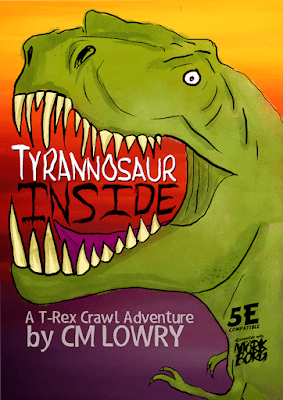 Scenarios set on or within the bodies of enormous creatures are not new. For example, Genial Jack, is set entirely within the body of a blue whale and On the Shoulders of Giants is set not on the body of a single god, but the bodies of twelve gods. However, Tyrannosaur Inside – A T-Rex Crawl Adventure is very probably the first scenario to be set inside the body of the most notorious dinosaur of all time—the tyrannosaurus rex. Which is both bonkers and fun, but also, a bit “Tell me again, how I use this?”. Published by Beyond Cataclysm Books following a successful Kickstarter campaign, the scenario is designed to be played using with Mörk Borg, the Swedish pre-apocalypse Old School Renaissance retroclone designed by Ockult Örtmästare Games and Stockholm Kartell and published by Free League Publishing. (In addition, it should be noted that a version is also available for use with Dungeons & Dragons, Fifth Edition.) It is not specifically set in the same doomed land as Mörk Borg, in fact, it is probably too over the top, if not a little silly, yet if the Game Master wants to set it in the same world, there is nothing to stop her. At best, and because it does involve a fifteen-thousand-pound meat-eating theropod, Tyrannosaur Inside – A T-Rex Crawl Adventure, works as a one-shot. This does not mean Tyrannosaur Inside – A T-Rex Crawl Adventure cannot be dropped into a campaign. It has the same effect as dropping a tyrannosaurus rex onto a village, which is exactly how the scenario starts.
Scenarios set on or within the bodies of enormous creatures are not new. For example, Genial Jack, is set entirely within the body of a blue whale and On the Shoulders of Giants is set not on the body of a single god, but the bodies of twelve gods. However, Tyrannosaur Inside – A T-Rex Crawl Adventure is very probably the first scenario to be set inside the body of the most notorious dinosaur of all time—the tyrannosaurus rex. Which is both bonkers and fun, but also, a bit “Tell me again, how I use this?”. Published by Beyond Cataclysm Books following a successful Kickstarter campaign, the scenario is designed to be played using with Mörk Borg, the Swedish pre-apocalypse Old School Renaissance retroclone designed by Ockult Örtmästare Games and Stockholm Kartell and published by Free League Publishing. (In addition, it should be noted that a version is also available for use with Dungeons & Dragons, Fifth Edition.) It is not specifically set in the same doomed land as Mörk Borg, in fact, it is probably too over the top, if not a little silly, yet if the Game Master wants to set it in the same world, there is nothing to stop her. At best, and because it does involve a fifteen-thousand-pound meat-eating theropod, Tyrannosaur Inside – A T-Rex Crawl Adventure, works as a one-shot. This does not mean Tyrannosaur Inside – A T-Rex Crawl Adventure cannot be dropped into a campaign. It has the same effect as dropping a tyrannosaurus rex onto a village, which is exactly how the scenario starts. 

